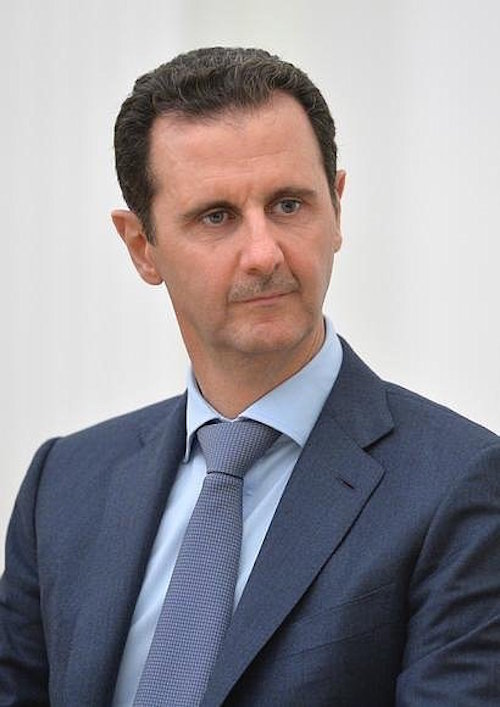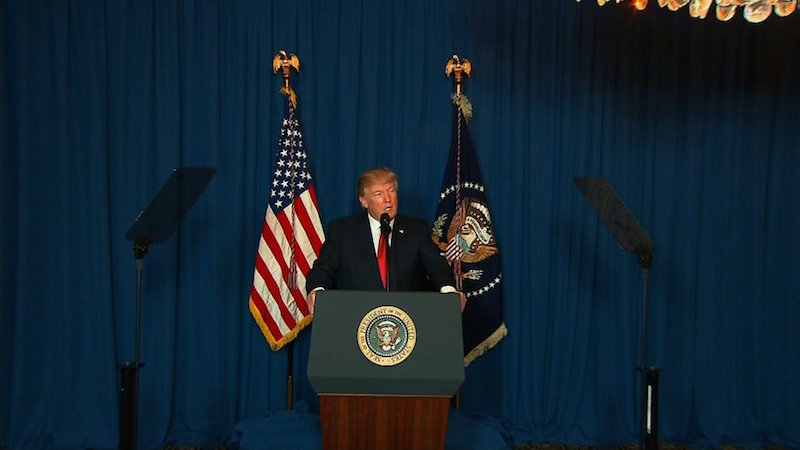Trump launches military strike against Syria
Published at | Updated at(CNN) — The United States launched a military strike Thursday on a Syrian government target in retaliation for their chemical weapons attack on civilians earlier in the week.
On President Donald Trump’s orders, US warships launched between 50-60 Tomahawk cruise missiles at a Syrian government airbase where the warplanes that carried out the chemical attacks were based, US officials said.
“Tonight, I ordered a targeted military strike on the air field in Syria from where the chemical attack was launched,” Trump said during short remarks to reporters at Mar-a-Lago. “It is in this vital national security of the United States to prevent and deter the spread and use of deadly chemical weapons.”
WATCH | TRUMP’S FULL REMARKS: ‘NO CHILD OF GOD SHOULD EVER SUFFER SUCH HORROR’
He added: “There can be no dispute that Syria used banned chemical weapons, violated its obligations under the Chemical Weapons Convention and ignored the urging of the UN Security Council. Years of previous attempts at changing Assad’s behavior have all failed and failed very dramatically.”
A US defense official said the strike was targeted on runway, aircraft and fuel points. The missiles were launched from warships in the Eastern Mediterranean.
Strikes are over “until another decision is made,” the official said.
The strikes are the first direct military action the US has taken against the leadership of Syrian President Bashar al-Assad in the country’s six-year civil war and represent a substantial escalation of the US’ military campaign in the region, which could be interpreted by the Syrian government as an act of war.
There were Russians at the base that the US struck Thursday night, a US defense official. It was not said what the Russians’ role was at the base. In addition, according to the official, the US had multiple conversations with the Russians today to warn them of the coming attack.
Separately, in an effort to tie the US strike to the chemical attack, the US military showed reporters an image of the radar track of a Syrian airplane leaving the airfield and headed to chemical strike area on Tuesday. A second image of bomb damage craters at the airbase was also shown to reporters at the Pentagon.
Lawmakers generally supported Trump’s decision to strike back against Assad Thursday night, but cautioned the President against unilaterally starting a war without first consulting Congress.
A pair of defense hawks — Sens. John McCain and Lindsey Graham — who have frequently been critical of Trump, roundly praised his decision Thursday night.
“Acting on the orders of their commander-in-chief, they have sent an important message the United States will no longer stand idly by as Assad, aided and abetted by Putin’s Russia, slaughters innocent Syrians with chemical weapons and barrel bombs,” McCain and Graham said in a joint statement.
But Sen. Rand Paul called on Trump to consult on Congress.
“While we all condemn the atrocities in Syria, the US was not attacked,” Paul said.

The US began launching airstrikes in Syria in September 2014 under President Barack Obama as part of its coalition campaign against ISIS, but has only targeted the terrorist group and not Syrian government forces.
Trump met with his national security team before his dinner with Chinese President Xi Jinping in Mar-a-Lago Thursday, where he made the decision to pull the trigger on the biggest military action of his presidency, an administration official says.
He sat through dinner with the President Xi as action was under way.
Defense Secretary James Mattis has been updating Trump about the missile strikes in Syria following his dinner with Xi, according to a US official.
Mattis, Secretary of State Rex Tillerson and Trump’s national security adviser Gen. H.R. McMaster were with Trump at Mar-a-Lago at the time. Vice President Mike Pence remained in Washington, where he returned to the White House after dinner.
Trump’s order to strike the Syrian government targets came a day after he said the chemical attacks — whose grisly effects were broadcast worldwide where videos captured in the immediate aftermath — “crossed a lot of lines for me” and said he felt a “responsibility” to respond.
“I will tell you it’s already happened that my attitude toward Syria and Assad has changed very much,” Trump said.
“When you kill innocent children — innocent babies — babies — little babies with a chemical gas that is so lethal, people were shocked to hear what gas it was, that crosses many, many lines. Beyond a red line, many, many lines,” Trump said.
Trump’s decision to launch the strikes, the most significant military action of his young presidency, came nearly four years after the US first concluded that Syrian forces had used chemical weapons in Syria. The Obama administration concluded that Syria had violated the “red line” Obama had set a year earlier in discussing the use of chemical weapons, but ultimately decided against military action against Syria in favor of a Russian-brokered deal to extricate the country’s chemical weapons stockpile.
Trump at the time said the US should “stay the hell out of Syria” and urged Obama on Twitter to “not attack Syria” in the wake of the 2013 chemical attack.
“There is no upside and tremendous downside. Save your ‘powder’ for another (and more important) day,” he tweeted in September 2013.
Trump repeatedly criticized Obama during his presidential campaign for not acting on his “red line” threat, but the real estate mogul also argued against deepening the US’ military involvement in Syria, particularly as it related to Assad.
Trump argued last May in a TV interview that he would “go after ISIS big league,” but said he did not support targeting Assad’s regime, arguing the US has “bigger problems than Assad.”
Syria’s six-year civil war has claimed the lives of at least 400,000, according to a United Nations estimate released a year ago. More than 5 million Syrians have fled the country and more than 6 million more have been displaced internally, according to UN agencies.
But guided by his “America First” ideology and rejection of the US’ propensity for “nation-building,” Trump did not argue in favor of stepped-up US intervention during his campaign for president.
Instead, he signaled the opposite: He argued that the US should remain laser-focused on defeating ISIS and vowed to try and partner with Russia, which has heartily backed Assad’s regime, in order to defeat ISIS and bring the conflict to an end.
Those views appeared steeped in his longstanding criticism of the Iraq War, which he called a “stupid” decision, lamenting the billions of dollars funneled toward that war effort instead of on domestic programs, like infrastructure spending.
While Trump rejected the isolationist label some placed on him during the campaign, he made clear that his preference was for limiting the US footprint around the world and refocusing US foreign policy around core national security interests.
RELATED CONTENT:
Russia challenges Trump to say what he would do about Syria
My family’s gone: Syrian man says 25 relatives died in strike




